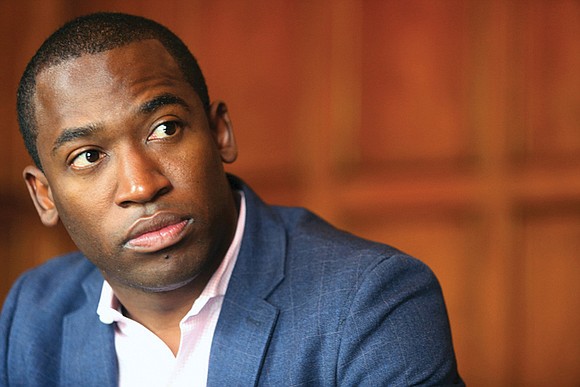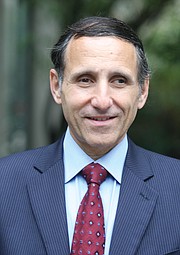‘Pathetic’
School advocate Paul Goldman fumes over mayor’s school funding resolution that he claims does not meet City Charter requirement
Jeremy M. Lazarus | 1/18/2019, 6 a.m.
Mayor Levar M. Stoney appears to be backpedaling on his pledge to meet a new City Charter requirement to provide “a fully funded plan to modernize” Richmond’s decaying school buildings.
He did not “formally present” his full-blown plan to City Council Monday night as the charter provision requires, nor has he met another requirement to “provide an opportunity for public participation” in the development of the plan.
Instead, Mayor Stoney quietly submitted to City Council a three-paragraph resolution that calls on the council to endorse his idea of using the city’s borrowing capacity over 20 years to fully pay for $800 million in school renovation and construction projects by 2048.
The mayor was not available for comment. But his chief of staff, Lincoln Saunders, and press spokesman, Jim Nolan, separately told the Free Press the mayor had not considered speaking to the council and that he regarded the resolution drafted by the City Attorney’s Office as meeting his obligation for a financing plan.
While members of City Council have remained mum on the resolution, advocates for modernizing the city’s schools disagree.
“Pathetic,” said Paul Goldman, leader of the Put Schools First campaign and the creator of the charter provision that won 85 percent voter support in 2017 and overwhelming approval from the General Assembly last year.
Mr. Goldman has spent 13 years championing the idea that Richmond students need and deserve modern schools as a matter of justice and fairness. He is dismayed that the mayor believes he has met the charter requirements by “presenting a piece of paper that, if passed, would not be binding on him, future mayors or future councils. This is not a plan — just another empty promise,” Mr. Goldman fumed.
“No one who reads the charter provision would believe that this kind of flimsy resolution would meet his obligation to offer a fully funded plan.”
Mr. Goldman, a former chairman of the Virginia Democratic Party, helped create Richmond’s at-large mayor position first won by former Gov. L. Douglas Wilder in the November 2004 election. He also helped the former governor become the first African-American to win statewide office in Virginia as lieutenant governor in 1985.
Mr. Goldman called it “unconscionable” that the mayor, who campaigned on modernizing schools and criticized his predecessor for failing to get the job done, would present a resolution that Mr. Goldman said “would essentially guarantee that in 10 years, the majority of kids will be attending schools that are even more decrepit than they are now. This is not what the people voted for.
“This shows his real priority,” Mr. Goldman continued. “When it comes to the Coliseum, the mayor is trying to put together a binding, 30-year commitment. But when it comes to schools, he says that kind of commitment is not needed.
“Would he say that to Tom Farrell (leader of the effort to replace the Coliseum)? Of course not. But when it comes to poor, mostly African-American kids whom Virginia Tech studies show are being deprived of a quality education due to the condition of the city’s school buildings, he’s more than willing.”
According to the City Charter, “the ball is now in City Council’s court,” Mr. Goldman said. “The members now have 90 days to take such action as they deem appropriate. And they can scuttle this resolution and create a real plan if they choose to.”
Mr. Saunders said the mayor did not provide a full listing of how the money is to be spent because he is leaving it to the School Board to make such decisions, which he said is one of the board’s duties under the state Constitution.
Mr. Saunders added that the mayor drew the $800 million figure from a proposed Plan A that was presented to the School Board in late 2017 and cited that figure.
The School Board has yet to approve the entire Plan A, according to the board’s minutes, even though some members, including board Chairwoman Dawn Page, 8th District, insist otherwise.
Plan A and an alternative, Plan B, were the creations of then-interim Superintendent Thomas E. “Tommy” Kranz and provided projected estimates of the work to be done on 40 school buildings.
Both options were incomplete; a number of significant buildings were left off both lists, including the Technical Center’s two deteriorating structures that are key to career training and the aging Amelia Street School that serves physically disabled students.
At the time, Mr. Kranz presented the two options, which were not released publicly, both he and the board believed that the city was unlikely to fund most of the work. The plans were developed before the mayor pushed through a 1.5 percent increase in the city’s meals tax last February to provide up to $150 million for school construction.
In December 2017, a split School Board adopted the first phase of the 20-year Plan A, a $225 million package that called for development of five new schools and renovations to two others.
At this time, City Hall and the School Board have agreed to spend about $110 million from the increased funding provided by the meals tax to develop only three schools, including two replacement elementary schools, George Mason and Greene, and a replacement middle school, Elkhardt-Thompson.
The School Board has yet to revisit Plan A or B, reconsider a separate Option 5 building plan that was approved by the board in 2015 or consider how any future dollars would be spent.
Mr. Goldman said that means the School Board does not have a plan, either.
“If the mayor’s resolution passes and nothing more gets done, this matter will have to be settled in the 2020 election,” he said. “Voters will then have to decide whether modernizing schools should be the top priority or not.”








